Turtle rescue season has begun at Shoreline Aviation, GHG
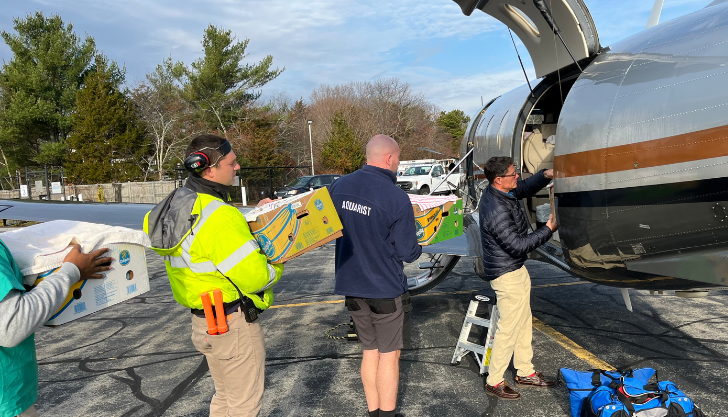
Even ABC News thinks this is newsworthy.
Biologists Kristen Luise and Alexis Wrate draw up on the ramp at Marshfield Municipal Airport in late November with 30 flight passengers in the back of their SUV, where they are greeted by airport operator Shoreline Aviation staff.
Minutes later a Pilatus PC-12 turboprop lands on the runway, detouring in its route south from New York, and taxies onto the ramp. Pilot Steve Bernstein is used to landing in Marshfield, loading a few dozen passengers into his eight-seat cabin, and zipping off again, headed to the warmer climate of North Carolina.
If his waiting passengers had a clue as to what was going on, they’d be plenty grateful. Even if quarters would be a bit cramped. It certainly beats the alternative.
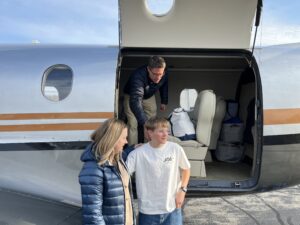
Debbi and Owen Bernstein wait for husband/dad Steve Bernstein to prep his Pilatus PC-12 for loading turtles.
Kristen and Alexis work at New England Aquarium in the Rescue Department. They work with cold-stunned sea turtles, and this is cold stun season.
“As the temperature drops in Cape Cod Bay, turtles’ body temperature drops as well, because they’re reptiles; they’re ectotherms,” Kristen explained as the biologists waited for the aircraft transport to arrive. “What happens is their metabolism begins to shut down, and they become immobilized and come to be stranded on the beaches of Cape Cod. When that happens, they come to our Sea Turtle Hospital in Quincy, and that’s where the rehabilitation process begins.”
There, they will go through a few weeks of rehabilitation before being deemed ready to move on.
“So, we’re here to send 30 turtles to North Carolina to continue rehab, so that way we can have more space at our hospital for more turtles to come in.”
What happens is turtles come into the bay in the summertime to forage, and when the water temperature starts dropping in October and November, that’s the signal to start swimming south. But the hook of the Cape prevents their southward progress. They get cold, become debilitated, and start floating on the surface. They then wash up onto the land and become stranded.
“We have partners at Wellfleet Bay Wildlife Sanctuary with Mass Audubon,” Kristen said. “They have staff and volunteers that walk the beaches, and they collect the turtles and bring them to us.”
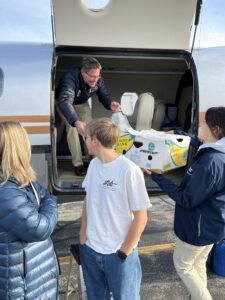
Loading begins as New England Aquarium biologist Alexis Wrate hands pilot Steve Bernstein a veggie crate full of rehabilitating turtles.
Here’s a report on the turtle rescue mission by ABC News, including a photo from this Marshfield event.
Steve Bernstein has been transporting turtles as an active volunteer for the organization Turtles Fly Too for about 10 years. TFT’s mission: “… is to facilitate the use of general aviation to transport endangered species and to promote conservation through education and outreach.”
Steve’s son, Owen, has been involved in turtle transport for five years, since he was 10. He and his mom, Debbi, flew in with Steve to pick up the 30 rehabilitating turtles.
“I’ve been flying with my dad on missions, and it’s awesome to see the work that Turtles Fly Too is doing,” Owen said during a brief break from helping the biologists and Shoreline Aviation staffers load turtles onto the PC-12 with Steve. “It’s an awesome program.”
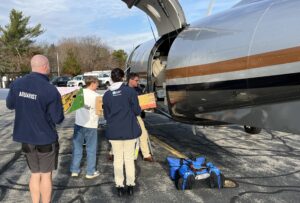
Rehabilitating turtles are loaded on volunteer pilot Steve Bernstein’s Pilatus PC-12 to fly to North Carolina for more rehab before being released.
His mom agreed. “If we’re traveling south and we have the opportunity to help the turtles get to the rehabilitation center near Beaufort, North Carolina, we’re glad to,” she said.
Steve flies turtles into Beaufort, and they are taken to the nearby North Carolina Aquarium at Pine Knoll Shores, he said. There, they will receive further rehabilitation before being released into the warm southern waters they were meant to find.
“This is our 10th year doing this,” Steve said. “Owen and his brother, Jake, and their sister, Hannah, are veteran turtle fliers. It’s a big team effort; that’s the theme. We get the glory, but there’s a whole bunch of folks, many of them volunteers, who work together and jump through a lot of hoops logistically and in terms of the permits and permissions required, because of the endangered status of the turtles. It’s quite a bit of work, and we just get to fly, so our role is the easiest.”
Shoreline charges no ramp fees and offers significant fuel discounts for Turtle Fly Too pilots. And their staffers get to help with loading the turtles onto the aircraft.
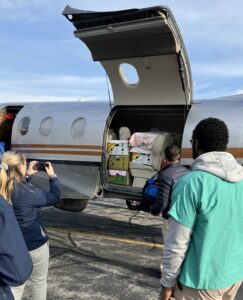
NEA senior biologist Kristen Luise snaps photos of her departing patients as they are about to be closed in for the flight to North Carolina.
This day’s batch includes Kemp’s ridsley, loggerhead, and green turtles, Kristen said. The Kemp’s ridley is the smallest sea turtle in the world and is on the endangered species list. It is named for Richard Kemp, a fisherman from Key West, Florida, who submitted the turtle for identification in 1906. They used to be abundant, but the population crashed in the mid-20th century. Commercial and recreational fishing gear is a big threat to this turtle.
Kristen has been involved in this rescue/rehab program for six years, first as a volunteer, then as an intern, and now as a New England Aquarium senior biologist. Alexis has been with NEA for a year, and this is her second transport. Kristen says they’ll rescue an average of about 400 turtles a season, which runs from early November to the beginning of January.
And over her six years transporting rescued turtles, she’s handed her turtles off to pilot Steve Bernstein at Marshfield Airport a number of times.
“Steve’s terrific,” she said. “He’s a great guy!”
He must be, if he believes that turtles fly too.
Back to News